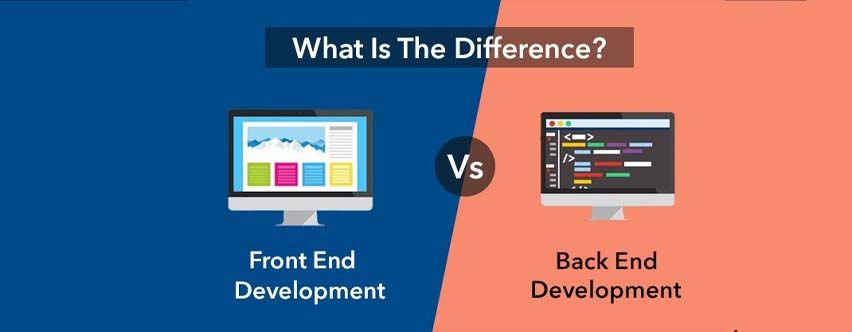In the fast-paced world of web development, two distinct realms reign supreme: the front-end and the back-end. These domains form the backbone of every website and web application, yet they differ significantly in their roles, responsibilities, and technologies. To shed light on this divide, we’ll embark on a journey to explore the intricacies of front-end vs. back-end development.
Table of Contents
What is Front-End Development?
Front-end development, often referred to as “client-side” development, deals with everything users see and interact with on a website or web application. Front-end developers are responsible for creating the user interface (UI) and ensuring a seamless user experience (UX). They focus on the presentation layer, using a combination of languages and technologies to bring web designs to life.
Key Front-End Technologies:
- HTML (Hypertext Markup Language): The foundation of every web page, HTML provides the structure and content of a webpage.
- CSS (Cascading Style Sheets): CSS is used to control the layout and design of web pages, making them visually appealing.
- JavaScript: This versatile scripting language adds interactivity and dynamic behavior to web pages, enhancing user engagement.
- Frameworks and Libraries: Front-end developers often leverage frameworks like React, Angular, or Vue.js, as well as libraries like jQuery, to streamline development.
What is Back-End Development?
Contrasting with front-end development, back-end development, also known as “server-side” development, focuses on the behind-the-scenes aspects of a website or web application. Back-end developers work on server-side logic, databases, and application architecture, ensuring data retrieval, storage, and processing.
Key Back-End Technologies:
- Server-Side Languages: Back-end developers commonly use languages like Python, Ruby, PHP, Java, and Node.js to build server logic.
- Databases: Storage and retrieval of data are critical, and databases like MySQL, PostgreSQL, MongoDB, and Oracle are essential tools.
- APIs (Application Programming Interfaces): APIs enable communication between the front-end and back-end, facilitating data exchange.
- Frameworks: Frameworks like Ruby on Rails, Django, Express.js, and Laravel provide a structured approach to back-end development.
Front-End vs. Back-End: A Comparison
Let’s delve into the key differences between front-end and back-end development through a comparison table:
| Aspect | Front-End Development | Back-End Development |
|---|---|---|
| Focus | User interface (UI) and user experience (UX) | Server-side logic, databases, and application architecture |
| Technologies | HTML, CSS, JavaScript, front-end frameworks and libraries | Server-side languages, databases, APIs, back-end frameworks |
| User Interaction | Deals with what users see and interact with | Handles data processing and storage |
| Responsiveness | Ensures the website is visually appealing and user-friendly | Manages data integrity and security |
| Client-Side Processing | Executes in the user’s web browser | Runs on the web server |
| Code Execution | Client-side | Server-side |
| Examples | Webpage layout, animations, forms, client-side validation | User authentication, database management, server routing |
Stats and Trends
Understanding the current landscape of front-end and back-end development is crucial for developers and businesses. Here are some insightful statistics and trends:
Front-End Development:
- According to the Stack Overflow Developer Survey 2021, JavaScript remains the most commonly used programming language among developers, indicating the significance of front-end development.
- The rise of Single Page Applications (SPAs) and Progressive Web Apps (PWAs) has led to increased demand for front-end frameworks like React and Angular.
- The demand for responsive web design and mobile-first development continues to grow, emphasizing the importance of front-end development in creating cross-device experiences.
Back-End Development:
- Serverless architecture is gaining popularity, enabling developers to focus on code without managing servers directly.
- The adoption of microservices and containerization (e.g., Docker) has revolutionized back-end development, promoting scalability and flexibility.
- Security concerns have led to increased demand for back-end developers skilled in data protection and threat mitigation.
FAQs About Front-End and Back-End Development
1. Can one person be both a front-end and back-end developer?
Yes, individuals with skills in both front-end and back-end development are often referred to as “full-stack developers.” They have a comprehensive understanding of web development and can work on all aspects of a project.
2. Which development role has a higher earning potential?
Salaries can vary depending on location, experience, and specialization. Historically, back-end developers have tended to earn slightly more due to the complexity of their work, but the gap is closing as full-stack developers become more common.
3. How do front-end and back-end developers collaborate?
Front-end and back-end developers collaborate through well-defined APIs (Application Programming Interfaces). The back-end exposes APIs that the front-end can use to retrieve and send data. This separation of concerns ensures modularity and allows for parallel development.
4. Is one area of development more important than the other?
Both front-end and back-end development are equally important. A visually stunning front-end can attract users, but a robust and secure back-end is essential for data management, scalability, and overall functionality. The success of a web project often depends on the harmonious interaction between these two domains.
Conclusion
Front-end and back-end development are two sides of the same coin, working in tandem to create impressive and functional web experiences. Whether you’re captivated by the visual allure of front-end development or the data-driven intricacies of back-end development, both areas play indispensable roles in the digital world.
As you embark on your journey into web development, remember that specialization is valuable, but a broader understanding of both front-end and back-end can make you a versatile and sought-after developer. So, whether you’re crafting elegant user interfaces or architecting robust server systems, your contribution is vital to the ever-evolving web development landscape.


Leave a Reply